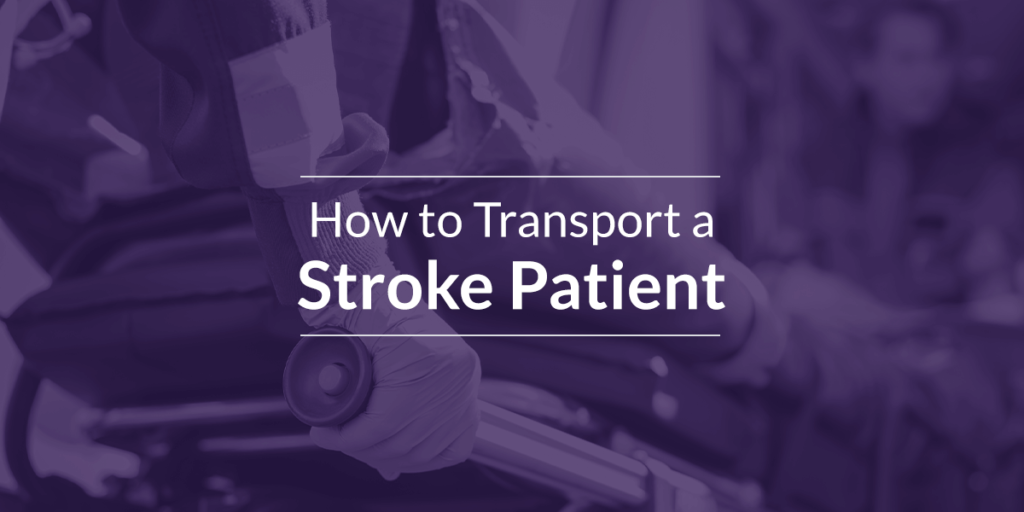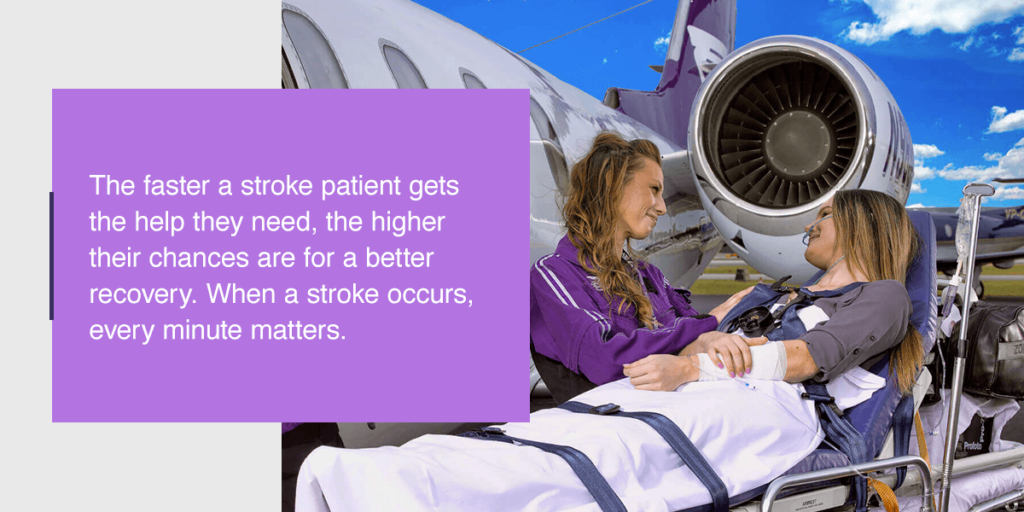
Strokes are serious medical conditions that are difficult to predict. The unfortunate truth is that strokes can happen to anyone at any time. It’s hard to tell if someone is susceptible to a stroke before it occurs, and a person can suffer from a stroke regardless of any preexisting conditions.
While a stroke could be impossible to predict, one thing remains clear. Getting someone the help they need after a stroke is paramount to their recovery. Let’s take a closer look at strokes to understand the best practices on how to transport a stroke patient. Getting help quickly is critical in the moments after a stroke. Finding the best way to transport a stroke patient could make all the difference in their long-term wellbeing.
What Is a Stroke?
A stroke is a medical emergency requiring prompt treatment for the best chance at a successful recovery. The Centers for Disease Control and Prevention (CDC) states that there are three distinct types of strokes:
- Hemorrhagic stroke: This is when a blood vessel in the brain bursts.
- Ischemic stroke: This is when a clot blocks blood flow in the brain.
- Transient ischemic attack: This is also known as a mini-stroke.
Ischemic strokes account for 87% of all reported strokes. The Mayo Clinic reports that ischemic strokes occur from an interruption or reduction of the blood supply to the brain. The result is a lack of oxygen and essential nutrients reaching the brain tissue. Within minutes, brain cells begin to die, and an ischemic stroke has occurred.
Here are some of the main symptoms and signs of a stroke:
- Trouble speaking or understanding words: A person may slur words, experience confusion or have difficulty understanding someone else’s words.
- Numbness or paralysis of the arm, leg or face: Numbness is a telltale sign that someone may be experiencing a stroke. Often, the numbness caused by a stroke will affect only one side of the body.
- Vision impairments: Blackened or blurred vision in one or both eyes can accompany a stroke. A related symptom may be double vision.
- Headache: A person suffering from a stroke could experience a headache along with potential dizziness, vomiting or some form of altered consciousness.
- Difficulty walking: Stumbling or losing balance could be a sign that someone is having a stroke. These symptoms may appear with a loss of coordination and dizziness.
Why Should You Take Care in Transporting a Stroke Patient?
Stoke patients vary in their long-term quality of life after the stroke. For many, the road to recovery is a long one. Patients may need to relearn skills like swallowing, walking or talking. Others may need an extended stay at an inpatient rehabilitation facility.
These outcomes are different for every stroke patient. But many studies find that a direct correlation exists between a stroke patient’s recovery and how quickly they receive medical treatment. The Washington Post reported findings from the Society of NeuroInterventional Surgery that show 65% of stroke patients survive without long-term disabilities when taken directly to a comprehensive stroke center.
In other words, the faster a stroke patient gets the help they need, the higher their chances are for a better recovery. When a stroke occurs, every minute matters.
Taking care of a patient during transportation, then, demands getting the patient to their destination as safely and quickly as possible.
You’ll want to keep the patient safe and comfortable during transportation. Sudden or aggressive movements may cause the patient to experience anxiety or pain. When speed and safety come together, the patient is in a much better situation to get the help they need and have a better chance at a positive recovery.

Is It Safe for Stroke Patients to Fly?
Air ambulance is a safe and effective way to transport people with medical needs over long distances. But should stroke victims fly? When can stroke patients fly after being admitted to a hospital?
Several factors come into play when determining if a stroke patient is safe to fly, including the following two:
- Type of stroke: A full stroke can leave a patient incapacitated. They need to get to the nearest stroke center as soon as possible, and this location is often a ground ambulance ride away. But one of the dangers of mini-strokes is that they could also be a warning sign of a full stroke to come. Plane rides run a small risk of exacerbating the medical conditions that lead to a mini-stroke. Patients with these conditions should use an air ambulance if they need to travel.
- Timing of stroke: The Stroke Association recommends that stroke patients avoid flying for the first two weeks after suffering a stroke. During these critical two weeks, patients could experience their most severe symptoms, making commercial flights dangerous. Stroke patients should use an air ambulance to keep them as safe as possible in the air.
Why May I Need to Transport a Stroke Patient?
The time may come when a stroke patient needs to leave their current location. You may need to transport a stroke patient for the following reasons:
- An individual suffered a stroke at home or in public and needs transportation to the nearest healthcare facility, preferably a facility with comprehensive stroke services.
- The stroke patient needs surgery or exams in another location in the current healthcare facility.
- The stroke patient requires services that their current healthcare facility is unable to provide, causing them to need relocation.
- The stroke patient is overseas and would like to reunite with their friends and family at a healthcare facility closer to home.
In each of the above scenarios, the stroke patient must move from point A to point B. And depending on their condition, they may need a great deal of assistance.
How to Transport a Stroke Patient
Whether you need to know how to transport an unresponsive stroke patient or a patient with minor symptoms, you’ll want to follow the best practices. Here are helpful protocols for the safe transport of a stroke patient:
- Be fast: Speed is crucial when transporting a stroke patient at any stage of their recovery. Air ambulance companies like REVA can get the patient to their location as quickly as possible.
- Know about proper medical arrangements and equipment: The stroke patient will need the right equipment and personnel to ensure a safe journey according to their condition. Whether they need ground or air travel, the circumstances need to be right for the patient’s needs. REVA ensures all proper conditions are met for every patient they transport.
- Schedule any needed ground services: When transporting a patient via air ambulance, you need to schedule all ground transport on both ends of the flight, if needed. REVA handles all needed aspects of a patient’s flight, helping you cover the small details.
Contact REVA for a Free Quote
In many situations, the best way to transport a stroke patient is via air ambulance. REVA can help you accomplish this. We handle every aspect of a patient’s air transportation needs, ensuring they get the proper treatment and care along the way. We emphasize safety to give you more peace of mind throughout the process.
Request a free quote today to take the next step toward your medical air travel needs.

About the Author
Dr. Farcy joined REVA in November 2015 and currently stands as REVA’s expert Medical Director. He is one of the preeminent physicians in the highly specialized field of emergency care and critical care medicine. Additionally, he lends his expertise as the senior editor of Critical Care Emergency Medicine, an industry-leading resource. He is an acclaimed international speaker and author in the emergency medicine and critical care field. He led the charge for numerous crisis relief efforts including the rescue projects after the 9/11 attacks in 2001. He is certified by the American Board of Emergency Medicine and also a member of the American Medical Association, the Society of Critical Care Medicine and the American College of Emergency Physicians.
